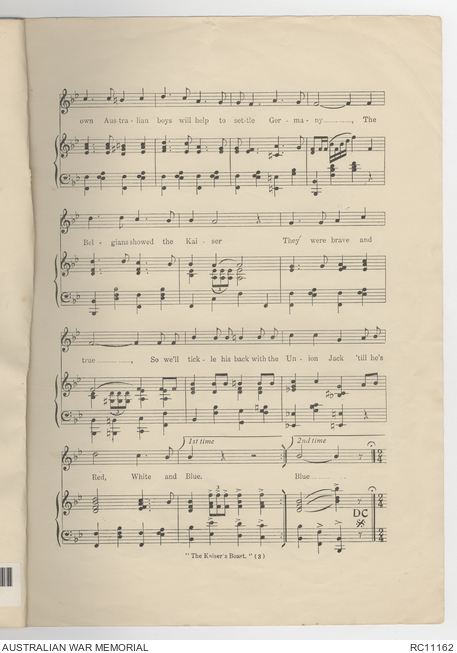| Accession Number | RC11162 |
|---|---|
| Collection number | Sheet Music Collection 677 |
| Collection type | Published Collection |
| Record type | Item |
| Item count | 1 |
| Measurement | Overall - closed: 35.8 cm x 25.5 cm |
| Object type | Sheet Music |
| Maker |
Hewitt, Stanley David |
| Place made | Australia |
| Date made | c 1916 |
| Conflict |
First World War, 1914-1918 |
[Sheet music] The Kaiser's boast




Sheet music for the song titled 'The Kaiser's Boast', written and composed by Sergeant Stanley David Hewitt. Hewitt was an Australian composer who served during the First World War. The song was first published in March 1916.
The cover of the music features a photograph of the composer in uniform. A caption on the cover notes "The composer, Sergeant Hewitt, is a Returned Wounded Soldier, having been shot right through one lung. Though suffering greatly through hemorrhage and weakness, he is independently handling his own clever composition throughout Victoria." The back cover of this piece music is blank and contains no advertisements or advertising previews of other music.
The Australian actress and singer, Dorothy Brunton, describing it as a 'dandy song' and requested permission to perform the song at fundraising events during the First World War period soon after it was first published. One report of the song soon after it was published appeared in The Bendigo Independent on 16 March 1916 where it reported that it was based on 'patriotic lines' and 'though not strikingly original, the music is pleasing, and the sentiment good'. The report continued to say that there was 'an attractive swing in the refrain'.
Stanley David Hewitt served with the 3rd Australian Infantry Battalion from August 1914 to May 1915, before being discharged and repatriated for medical reasons.
Towards the bottom of this page is a sound recording of this sheet music, or a parody, that was created as part of the Music and the First World War project. More information about this recording, including names of the performers, can be found on the catalogue record for the sound recording. A link to the catalogue record for the sound recording can be found at the bottom of this page, under the heading ‘Related objects’ where it can be identified with the prefix [sound recording].
- Download PDF document of [Sheet music] The Kaiser's boast (file)
-
Listen to
[Sheet music] The Kaiser's boast